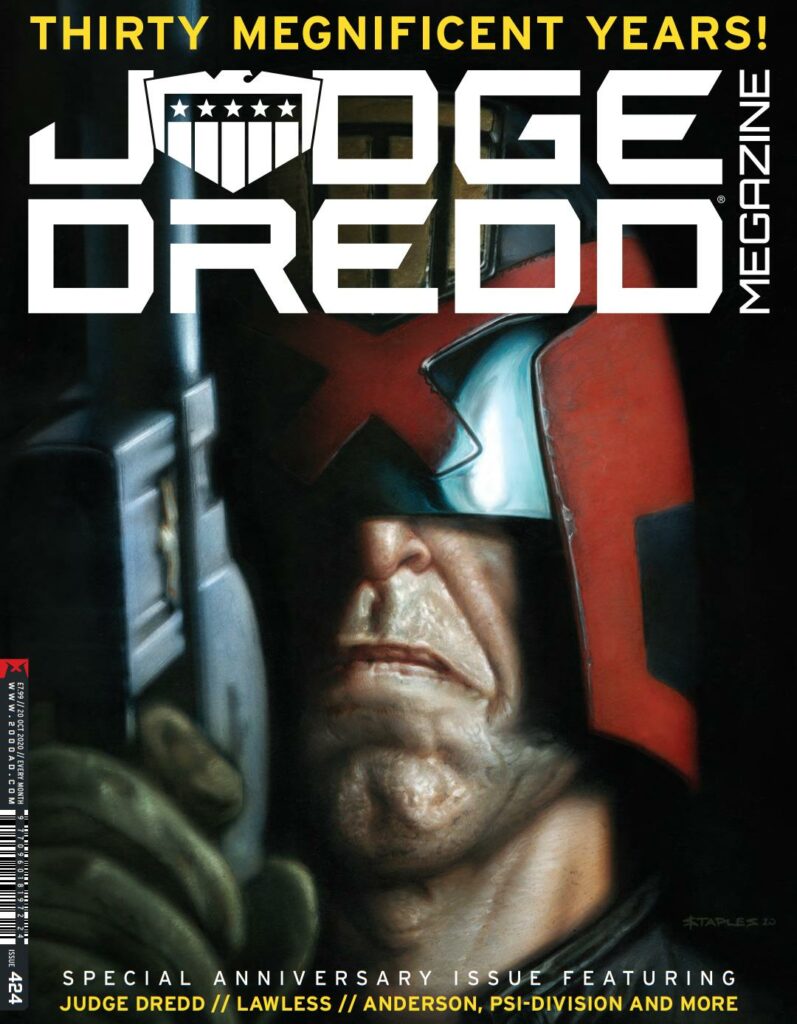Dreadnoughts: The world that would be Dredd’s with Michael Carroll & John Higgins
17th September 2020
‘Back in the Spring of 2035 we could almost
JUDGE VERANDA GLOVER, BOULDER, COLORADO, 2035 AD
feel the nation crumbling around us.’
That’s the opening line of the stunning new series Dreadnaughts, an explosive tale of the dawn of the Justice Department – coming to Judge Dredd Megazine issue 424 from writer Michael Carroll, artist John Higgins, and colour artist Sally Jane Hurst. Right now, the future has never looked closer.
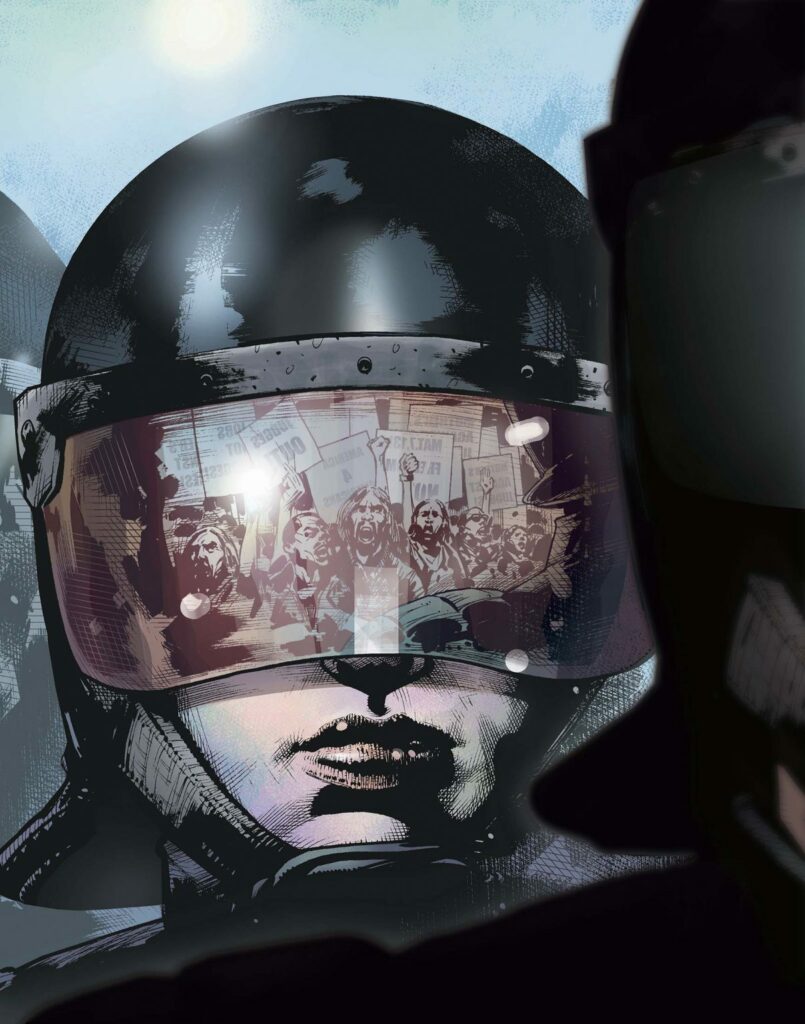
In Dreadnoughts, we’re diving into the explosive transition years between the recognisable policing and government of the modern-day USA and the new world order of the Justice Department of Mega-City One- just 15 years from now and yeet, in the modern world of now, it’s a world that seems just a few bad mistakes away.
I talked to Michael Carroll and John Higgins about the series for an interview that’s going to be published in the pages of Megazine issue 425, available mid-October.
But… there was so much to talk about and only a limited space in the Megazine, so we wanted to bring you both a good look at the world of Dreadnaughts here and include all of those ‘dvd’ extras not included in the Megazine interview.
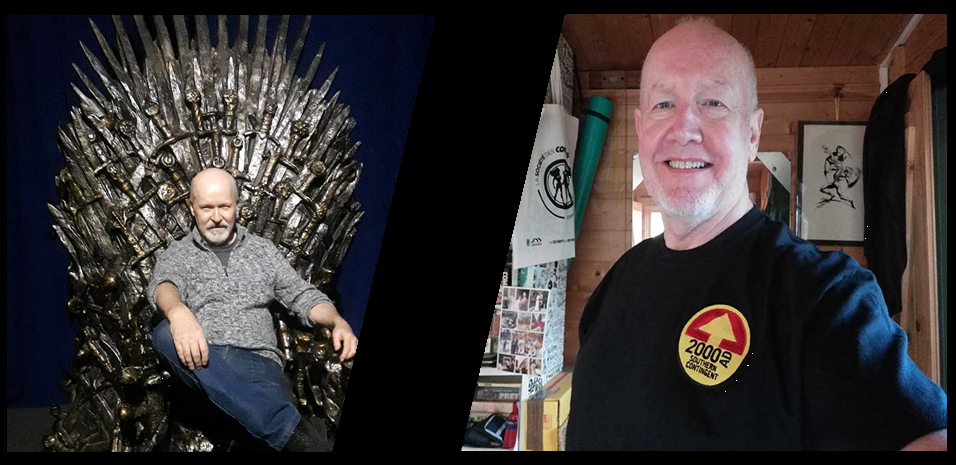
On the left – Michael Carroll, on the right – John Higgins
Dreadnoughts tells an all too possible tale of a nation giving away its democracy, a history of getting from here to there – showing just how easily it is for a nation to give away its freedoms for the easy, empty promises of making a country great again – frankly, being in the USA for the election in November this year, all this is very close to home.
In Dreadnoughts, we’re in the USA of 2035 AD, where the new Justice Department is still in its early years, and where Fargo’s Judges slowly but surely pushing into all levels of law enforcement; police, military, judiciary, and government.
‘For years, the country’s best political analysts
Judge Veranda Glover, Boulder, Colorado, 2035 AD
had warned us that disaster was inevitable
if we didn’t alter our course.
So we replaced those analysts with others
willing to provide more palatable answers…
…and then we were astonished to discover
that the problems still existed.’
Of course, Michael Carroll is no stranger to this world on the cusp of becoming the world we know in Judge Dredd, having written many of the Judges prose novels that cover the time period from the 2030s to 2070s, when traditional law is being transformed into the Justice Department regime we’re all used to seeing in the pages of Dredd.
Dreadnaughts chronicles the world seen in those Judges prose novels, but instead of jumping forward every book, the comic gives Carroll more chance to focus on a specific time and specific set of characters – as he says, ‘Dreadnoughts is a chance to ease off the throttle a bit.’
But it’s not just the Judges prose books that have set the stage for Dreadnoughts – Carroll again; ‘My five-part Judge Dredd strip “The Paradigm Shift” (2000 AD progs 2082 to 2086, with art by Jake Lynch, colours by John Charles and letters by Annie Parkhouse) was a sort of pilot for Dreadnoughts to see whether a comic-strip version of Judges could work – it was successful enough for Matt to green-light the series.’
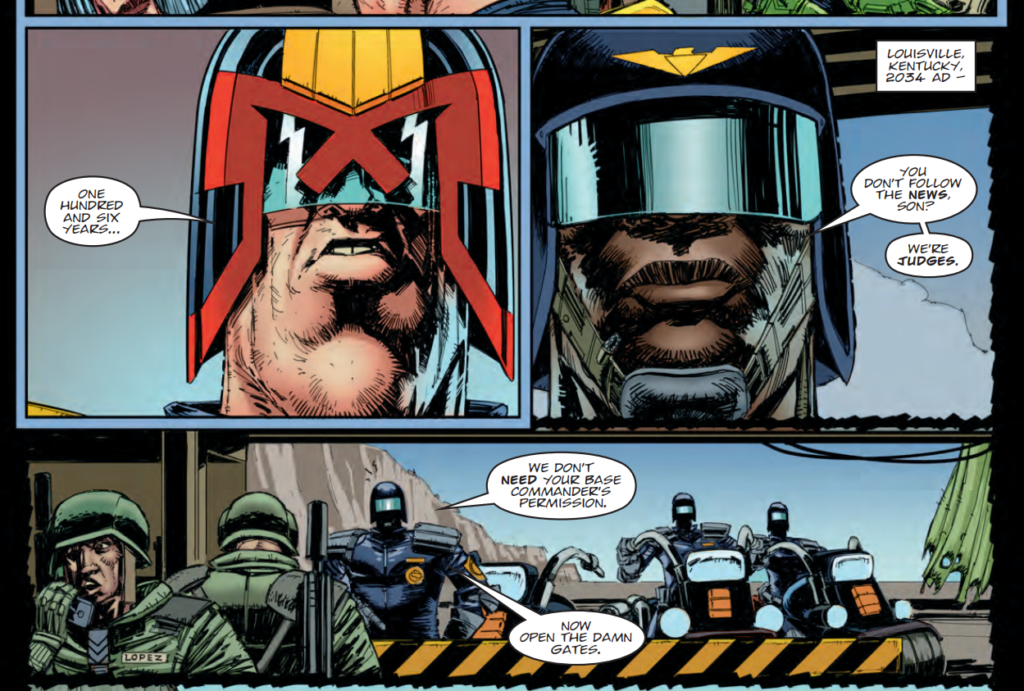
(2000 AD progs 2082 to 2086) – art by Jake Lynch
In this first series, Breaking Ground, we’re looking at the world through the eyes of newly-graduated, 40-year-old, Judge Veranda Glover. She’s joining a team of four Judges in Boulder, Colorado, under the leadership of Judge Venn. First time we see them – a demonstration that’s getting out of control.
Glover’s part of the new cadre of Judges, those who were not deep in law enforcement already, and she’s going to have a hard time working with those cop/Judges. ‘They all had other careers before they joined the new Department of Justice,’ says Carroll, ‘so for many of them this is just another job.’ So when Judge Glover comes in, literally with guns blazing, she’s bound to create friction.
The sort of friction that comes with Glover getting to the demonstration and immediately opening fire on the demonstrators, something Venn had expressly told the team not to do – the problem is that Glover wasn’t at that meeting –
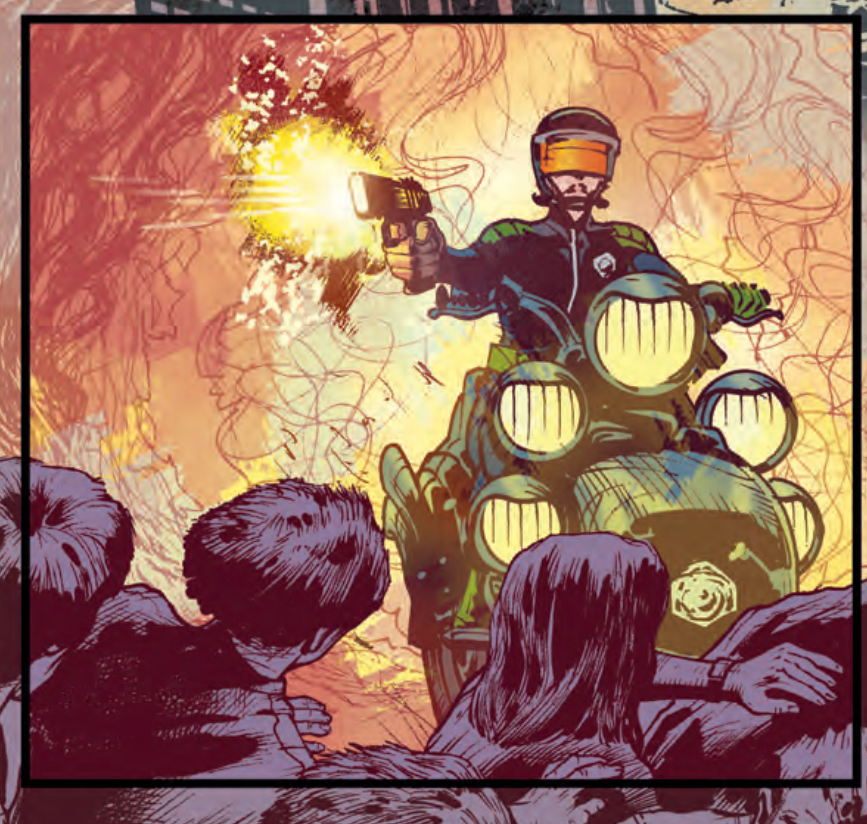
Doing a strip with the political overtones of Dreadnoughts in the current political climate is tapping into the spirit of the now, yet with Carroll and Higgins imagining what might happen in just a few years from now.
Yet Carroll is finding that the world he’s writing about in Dreadnoughts does seem to be coming closer and closer – ‘Oh yes, in the past few weeks we’ve seen heavily-armed masked civilians storming US government buildings in an attempt to force the government to comply with their wishes. Right now, such actions are permitted because they suit the government’s needs – get the people back to work to make more money for the billionaires – but when the people assemble in that manner to fight for something that might tip the balance of power, well, that invariably leads to a much bloodier outcome.’
And Carroll’s thoughts on how democracy fails are fascinating, both in the strip and in the moment – ‘To get from where we are now to the Judge system isn’t going to require the leaders to step down, but the people to step aside. Again, it goes back to the common cry of “Someone ought to do something!” History shows us that when the burdens of poverty and crime start to overwhelm the state the people will gratefully relinquish their power to those they believe will provide a better outcome.’
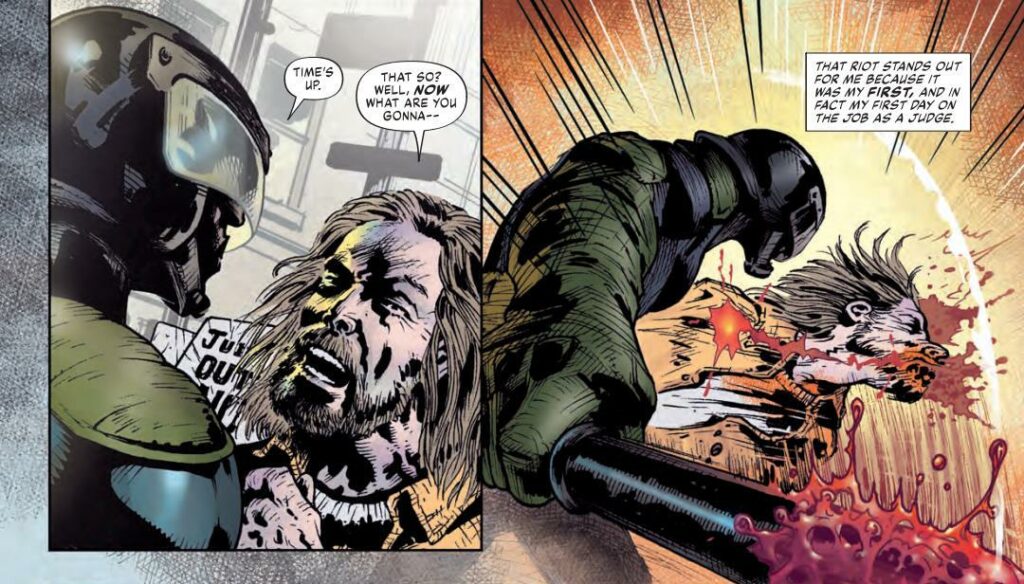
Carroll continues – ‘Would you rather be free but starving, or well-fed but not allowed to travel outside your designated zone without a permit? Idealism and nobility can help us stand tall and proud, but often they’re papier-mâché constructs: their perceived strength dissolves with the rain.’
And yes, Carroll does recognise that things are seemingly progressing in the wrong way far too quickly – ‘On a lighter note… I wrote the script for “Breaking Ground” in the summer of 2018, and one of the lines that appears in the first episode is, “no matter how strange something is, given enough time it just becomes the new normal.” There was no way I could have known then that the phrase “the new normal” would be bandied around so much in early 2020 that it’s already become a cliché!’
Now, when it comes to the whole idea of dealing with this pivotal period in the history of Mega-City One, Carroll’s aware that what’s being done in Dreadnoughts is pivotal, but he’s taking it slow – ‘Yes, it’s enormous,’ he says, ‘but we tackle it in bite-sized chunks! One of the biggest problems is that real-world events keep undermining us… Right now we have a planet-wide pandemic necessitating a lock-down, and one of the side-effects is the rise to prominence of the sort of people who automatically decide that anything which doesn’t suit them is part of a conspiracy against them.’
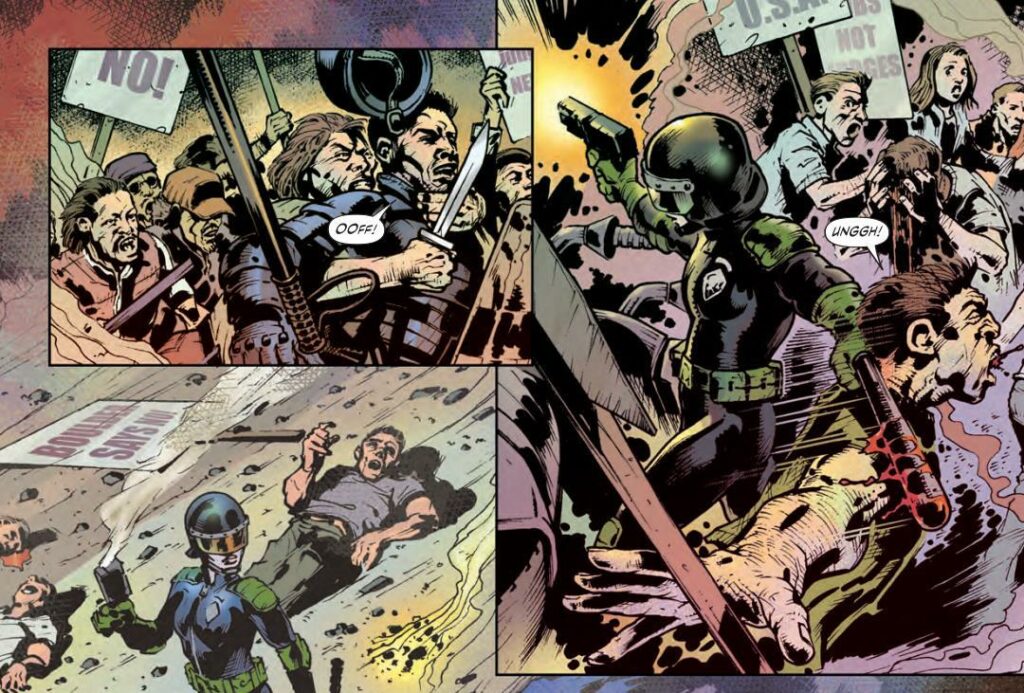
Having read just the first episode of Dreadnoughts at this point, I’ve got no idea where the story is going, but from what I’ve read in episode one, the story and art give us a brutal and brilliant look at a world just around the corner. And it’s a world that both Carroll and Higgins have put an awful lot of work into building.
Carroll talks of the idea of having Glover and the other Judges essentially being ‘security guards patrolling a building that’s simultaneously burning and sinking, while at the same time Fargo is attempting to break it apart so he can use the good bits to make a better, stronger building… to his own design.’
As to where it goes from this first series, Carroll says that, ‘it depends to some degree on the reaction to this first series, but I’ve planned out a few more series following Judge Glover over the course of several years.’ He continues to add that, ‘that highlights one of the main differences between these tales of the first Judges and the Dredd-era stories: our Judges can have a background, a past life that has shaped the Judge they’ve become, and elements of that background will linger.’
When it came to creating this world, John Higgins has been deeply involved with Dreadnoughts from the beginning, working on creating a future that’s recognisable to us from where we are now. Very much in the footsteps of Carlos Ezquerra, making a future that we could see from where we were at the time.
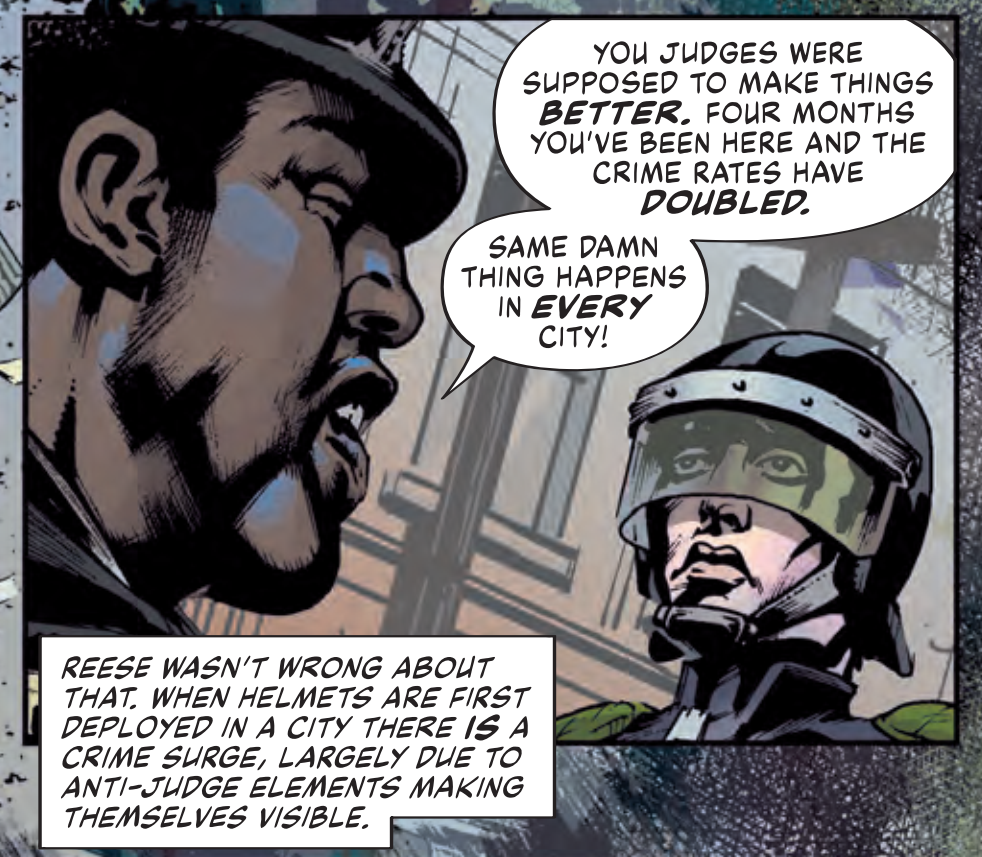
Higgins describes Dreadnoughts and the world-building involved as, ‘On one level, Dreadnoughts is the hardest SF comic strip I have ever had to draw, to visualise 10 minutes into the future, which I how I describe SF that is not jet packs, robots and FTL spaceships. No one can tell me my spaceship is wrong, but could if they were pedantic enough, to say “that is not the Broadway of Boulder City Colorado”, but then I would tell them to “fuck off!” as it is set in the near future 10 minutes from now and that is what it looks like then! Yes, I do get slightly piqued when people tell me such things, but otherwise I am pretty easy going!’
He continues, ‘To visualise this world is simple in theory, it is the same as we see now with any variations done to further the story, but thank goodness for Google maps, I can walk the streets that Judge Glover will walk, she and her fellow judges are the only, maybe slightly jarring SF elements on the streets, which in someway make Mike’s story more chilling by being set so close to the now we see outside.’
One difficulty Higgins has had to overcome here is that we’re so close to the events of Dreadnaughts, meaning that everything has to be recognidsable to us here in the 2020s – ‘It’s the same as looking at images from 30, 40 or even 50 years ago, nothing has changed in most forms we see except in little details, the everyday clothes we wear, the cars, transportation of any kind, buildings, all completely recognizable to anyone from 1970 and for us the designs in 2035 are going to be the same more or less as now.’
John is creating Dreadnoughts with colourist, Sally Jane Hurst, with a combination of traditional and digital, as he’s done since the 90s. He was an early adopter of digital comics-making, but acknowledges some of the limitations – ‘I love the possibilities of what digital can do, but I always wanted to be able to see the artists individual style in the art, which is something I believe you don’t get in digital. A number of things give digital illustration parameters with a generic veneer no matter the artist or subject matter, even with the new software that has developed to be more intuitive since those early days.’
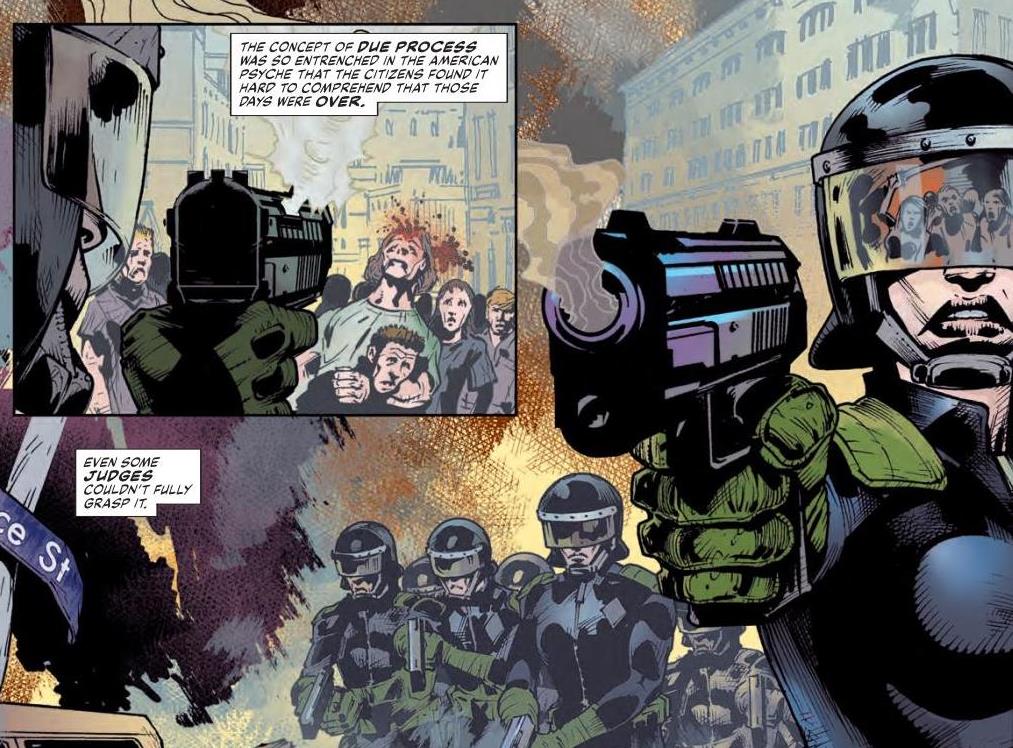
And of course, when it comes to worldbuilding, let’s face it, writers have it easy (sorry Mike)… after all, when he was doing those Judges prose novels, all he had to do was plant the idea in the reader’s head and they’d do the imagining work for him. But with comics, especially something so involved with world-building, it’s the artist who does the heavy lifting in so many ways….
I’m teasing, I’m teasing, but John did like that one – ‘Oooh and he is down! Can I kick Mike as the universal writer in the name of all other artists too? Ha ha, you said what all artists really truly believe.’ I think John’s at least partly joking there, but he continued – ‘Yes sometimes artists can feel hard done by. Particularly when writers write: PANEL 1. IN THIS PANEL 16 MILLION CITIZENS HIT THE STREETS OF MEGA CITY 1 – John Wagner did that to me once! Mike has had his moments in this series, maybe not quite to that level but close, crowds of rioters, phalanx’s of riot police, armed militia, the works!’
Winding things up, talk got to what their particular favourites were in the long history of 2000 AD – Carroll puts Dredd and Strontium Dog top of the list, along with The Stainless Steel Rat and The Ballad of Halo Jones. Following close behind he mentions Dan Dare, Kingdom, Ace Trucking Co., Rogue Trooper, Meltdown Man, Nikolai Dante… and I get the impression the list could go on and on!
When it comes to Higgins though, he’s quick to agree with Carroll about that list but singles out Rogue Trooper – ‘When it first appeared, seeing the first black line rendition of Rogue, Dave [Gibbons] depicted something slightly different to a human without it being obvious, when Rogue appears on the battlefield running out of the poisonous mist, that is a work of comic genius.’
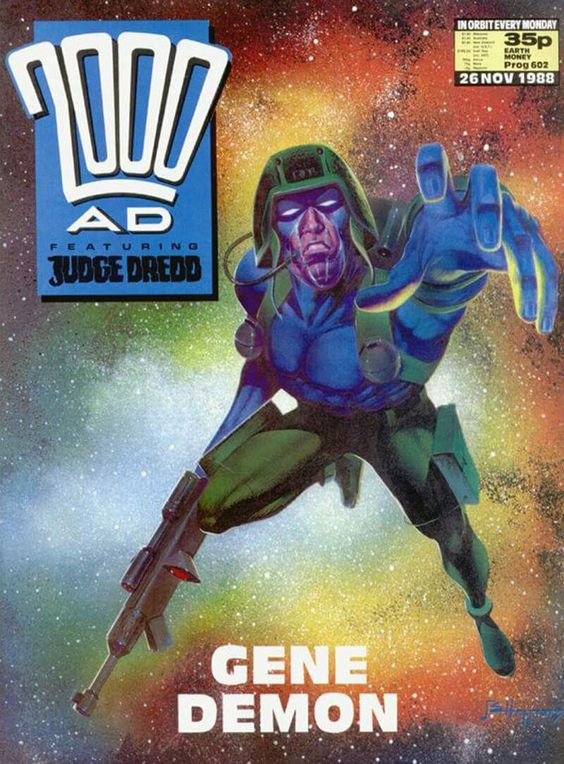
2000 AD Prog 602 (1988)
As far as what’s coming next from both Michael and John, you’ll be able to pick up Michael’s Judge Dredd Year Three novella, a further Judges novella, and he’s the editor on Judge Fear’s Big Day Out, a short story collection from the Megazine, which should be out in November (Covid permitting). You’re getting a brand-new series of Proteus Vex beginning in 2000 AD Prog 2200 and, finally for now, a four-part Dredd tale with art by Will Simpson. He’s also ‘spending far too much time working on Rusty Staples,’ and says, ‘I’ve got the standard writers’ collection of countless fire-dwelling irons, each of them awaiting the spark that’ll send them into the stratosphere and make me unbelievably rich and famous. I reckon it’s definitely my turn soon, right?’
As far as John, he’s got a similar number of projects, again describing them as ‘small sparks waiting to burst into full-blown conflagrations.’ Yep, there’s a writer and artist in synchrony! He also wants to do ‘something more with my character Razorjack which is an ongoing project of constant creativity.’
And both of them are hoping that they’ll be able to get back into the world of Dreadnoughts, with Higgins ending by saying, ‘I like Judge Glover, she chills me but I am close to trusting her, as I do Dredd, to do the right thing according to the Law.’
.
Dreadnoughts: Breaking Ground explodes into the pages of the Judge Dredd Megazine with issue 424, out on 16 September. Get it from the 2000 AD web shop.
And for a lot more from both Mssrs Carroll and Higgins, be sure to check out Megazine 425 for the full interview – where they talk Dreadnoughts in a LOT more detail!
